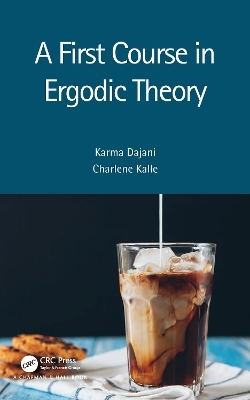
A First Course in Ergodic Theory
Chapman & Hall/CRC (Verlag)
978-1-032-02184-3 (ISBN)
A First Course in Ergodic Theory provides readers with an introductory course in Ergodic Theory. This textbook has been developed from the authors’ own notes on the subject, which they have been teaching since the 1990s. Over the years they have added topics, theorems, examples and explanations from various sources. The result is a book that is easy to teach from and easy to learn from — designed to require only minimal prerequisites.
Features
Suitable for readers with only a basic knowledge of measure theory, some topology and a very basic knowledge of functional analysis
Perfect as the primary textbook for a course in Ergodic Theory
Examples are described and are studied in detail when new properties are presented.
Karma Dajani earned her PhD degree from the George Washington University in DC and is currently an Associate Professor in Mathematics at Utrecht University in the Netherlands. She has over 30 years of teaching experience, close to 60 publications and is the co-author of the book Ergodic Theory of Numbers. Her research interests are primarily in Ergodic Theory and its applications to other fields such as Number Theory, Probability Theory and Symbolic Dynamics. Although Mathematics is her career but it is also one of her three passions: math, dance and classical music. Charlene Kalle earned her PhD in mathematics from Utrecht University. After postdoctoral positions at Warwick University and the University of Vienna, she moved to Leiden University where she is now an Assistant Professor in Mathematics. Her research is in ergodic theory with applications to probability theory. She is also interested in relations to number theory and fractal geometry. She was awarded two prestigious research grants from the Dutch Research Council NWO. Besides twenty research articles, she has co-authored a book on extracurricular high school mathematics. She has accumulated twenty years of teaching experience ranging from teaching Italian language to adults to lecturing master courses in mathematics. She mostly devotes her time not spent on mathematics to her three children and playing bridge.
Preface. Author Bios. 1. Measure preservingness and basic examples. 1.1. What is Ergodic Theory. 1.2. Measure Preserving Transformations. 1.3. Basic Examples. 2. Recurrence and Ergodicity. 2.1. Recurrence. 2.2. Ergodicity. 2.3. Examples of Ergodic Transformations. 3. The Pointwise Ergodic Theorem and its consequences. 3.2. Normal Numbers. 3.3. Characterization of Irreducible Markov Chains. 3.4. Mixing. 4. More Ergodic Theorem. The mean Ergodic Theorem. 4.2. The Hurewicz Erogdic Theorem. 5. Measure Preserving Isomorphisms. 5.2. Factor Maps. 5.3. Natural Extensions. 6. The Perron–Frobenius Operator. 6.1. Absolutely Continuous Invariants Measures. 6.2. Exactness. Densities for Piecewise Monotnoe Interval Maps. 7. Invariant Measures for Continuous Transformations. 7.1. Existence. 7.2. Unique Ergodicity and Inform Distributions. 7.3. Some Topological Dynamics. 8. Continued Fractions. 8.1. Basic Properties of Regular Continue Fractions. 8.2. Ergodic Properties of Gauss Map. 8.3. Natural Extension and the Doeblin–Lenstra Conjecture. 8.4. Other Continue Fraction Transformation. 9. Entropy. 9.1. Randomness and Information. 9.2. Definitions and Properties. Calculation of Entropy and Examples. 9.4. The Shannon–McMillan–Breiman Theorem. 9.5. Lochs’ Theorem. 10. The Variational Principle. 10.1 Topological Entropy. 10.2. Main Theorem. 10.3. Measures of Maximal Entropy. 11. Infinite Ergodic Theory. 11.1 Examples of Infinite Measure Dynamical Systems. 11.2. Conservative and Dissipative Part. 11.3. Induced Systems. 11.4. Jump Transformations. 11.5. Ergodic Theorem for Infinite Measure Systems. 12. Appendix. 12.1. Topology. 12.2. Measure Theory. 12.3 Lebesgue Spaces. 12.4. Lebesgue Integration and Convergence Results. 12.5. Hilbert’s Spaces. 12.6. Borel Measures on Compact Metric Spaces. 12.7. Functions of Bounded Variation. Bibliography. Index.
| Erscheinungsdatum | 26.07.2023 |
|---|---|
| Zusatzinfo | 19 Line drawings, black and white; 19 Illustrations, black and white |
| Sprache | englisch |
| Maße | 156 x 234 mm |
| Gewicht | 453 g |
| Themenwelt | Mathematik / Informatik ► Mathematik ► Analysis |
| Technik ► Umwelttechnik / Biotechnologie | |
| ISBN-10 | 1-032-02184-5 / 1032021845 |
| ISBN-13 | 978-1-032-02184-3 / 9781032021843 |
| Zustand | Neuware |
| Haben Sie eine Frage zum Produkt? |
aus dem Bereich


